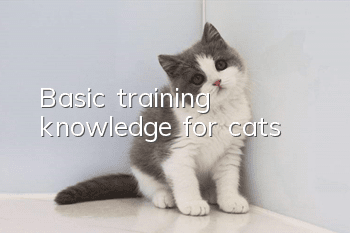Basic training knowledge for cats

Basic training knowledge for cats:
1. Cat’s name response training
The first step in training a cat is to make it remember itself The name can be called upon. The most effective way is to call the cat's name before eating. As long as it understands that it will get food when its name is called, it will naturally remember the pronunciation of its own name. Many owners usually like to talk to their cats. At this time, adding its name will be more effective.
2. Cat obedience training
When the cat misbehaves, reprimand it loudly, criticize it on the spot immediately, and immediately issue "no" and "no" instructions to stop it; Of course, the cat may not stop acting because it listened to the owner's words, but it may stop acting because it is frightened by the loud noise; if it does this repeatedly, the cat will gradually feel that it will be reprimanded loudly if it does so, so Just never do it again. Educate patiently. It does not mean that criticism today will be allowed tomorrow. It should be treated with the same attitude at all times. Be careful not to hit it frequently, because the cat's body is much smaller than that of a human and is easily injured. Moreover, the cat is relatively fragile and sensitive, and may hold a grudge against you. When the cat performs well, it must be praised and rewarded in time, so that it knows what is right.
3. Cat handshake training method
Prepare fish slices and other snacks that cats like, put some meat scent on your right finger, call the cat over, and stretch out your right hand to let it smell the scent. , and softly say: "Shake hands, shake hands." The cat will stretch its head to smell the smell in its hands. At this time, it will raise its hand, and the cat will stand up and stretch out its front paws, seizing the opportunity to hold the cat's right paw, and say "shake hands" at the same time, " "Shake hands" and pass the food to the cat with your left hand. When training a cat to shake hands with people, pay attention to your tone of voice being kind and gentle. In this way, the cat can master it after repeated training for a few days. After that, you only need to use food occasionally to consolidate the results of your pet's training. Normally, as long as you say "shake hands", the pet cat will naturally stretch out its paws to shake hands with you.
4. Fixed-point excretion training for cats
First of all, the cat must be trained to have the habit of defecating regularly. Usually, the cat litter box is placed in the bathroom and the door is closed to prevent the pet cat from entering and exiting at will. Open the door and let him poop. Then find a small plastic basin that can be placed stably in the toilet, put cat litter in it, and hold the cat in. Most cats will immediately know its use.
5. Cat not scratching furniture training
Before training, you should prepare a wooden post, which is 70 cm long and 20 cm thick. It should be fixed upright near the cat's nest for convenience. For cats to scratch, the texture of the wooden posts should be solid. Training should begin with kittens. During training, bring the kitten to a wooden post, grab the cat's two front legs with both hands, place it on the wooden post, simulate the cat's scratching action, so that the secretion of the glands on the cat's feet can be applied On a wooden post. After many times of training, coupled with the attraction of the smell of secretions, the cat will go to the wooden pillars to scratch. Develop this habit, itYou will no longer scratch the furniture, thereby protecting the cleanliness and beauty of the furniture.
- How to get rid of fleas on kittens?
- How old can a cat take hair removal cream? How often should cats use hair removal cream?
- Signs that a female cat doesn’t want to take care of her babies
- What vegetables do cats eat?
- What should you pay attention to when raising Burmese cats?
- What should I do if a hard lump bulges in the wound of a female cat after being neutered?
- Cat Injury Treatment First Aid Care Instructions
- Can cats eat cat food soaked in boiling water?
- What should Siamese cats eat if they have bad breath?
- Cat's drooling and runny nose may be caused by a cold



